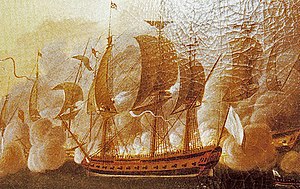French frigate Hermione (1779)

Hermione in the Naval battle of Louisbourg, by Auguste-Louis de Rossel de Cercy
|
|
| History | |
|---|---|
|
|
|
| Name: | Hermione |
| Builder: | Rochefort |
| Laid down: | March 1778 |
| Launched: | 28 April 1779 |
| In service: | June 1779 |
| Fate: | Ran aground and wrecked due to a navigation error of her pilot at Le Croisic on 20 September 1793 |
| General characteristics | |
| Class and type: | Concorde class 12-pounder frigate |
| Displacement: | 550 tons; 1160 ton burthen |
| Length: | 44.2 m (145 ft) |
| Beam: | 11.24 m (36.9 ft) |
| Draught: | 5.78 m (19.0 ft) |
| Complement: | 255 |
| Armament: |
|
The Hermione was a 12-pounder Concorde class frigate of the French Navy. She became famous when she ferried General Lafayette to the United States in 1780 for support to the Americans in the American Revolutionary War. She grounded and was wrecked in 1793.
In 1997, construction of a replica ship started in Rochefort, Charente-Maritime, France; the new ship is likewise named Hermione.
Hermione was built in eleven months at Rochefort, by the shipwright Henri Chevillard as a light (French: légère) frigate, fast and maneuverable. Between May and December 1779 she underwent successful sea trials in the Gulf of Gascony under the command of Lieutenant de Latouche.
General La Fayette embarked at Rochefort on 11 March 1780 and arrived in Boston on 28 April carrying the secret news that he had secured French reinforcements (5,500 men and 5 frigates) for George Washington. After the dramatic failure of the Penobscot Expedition, a large military expedition to dislodge the British from their new stronghold at the confluence of the Bagaduce and the Penobscot River on the east bank of Penobscot Bay in Maine (an area later known as Castine), the revolutionary council of Massachusetts asked Latouche if he would be willing to sail to Penobscot Bay for a quick military intelligence-gathering cruise, checking on the strength of the British garrison at Fort George. The Hermione then made the week-long voyage in mid-May, after which the frigate sailed to Rhode Island. Next, she got underway again on 2 June and suffered serious damage in the fierce but indecisive Action of 7 June 1780 against the 32-gun HMS Iris, under James Hawker.
...
Wikipedia
